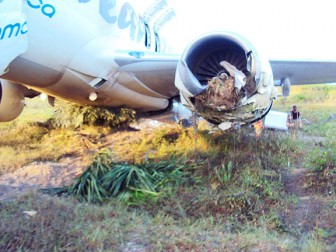Investigators are working around the clock to relocate Caribbean Airline’s Boeing 737 aircraft from the crash site at the Cheddi Jagan International Airport, Timehri before the end of this week to an unused hangar there.
The aircraft is being dismantled and reassembled in order to facilitate complete investigations into the incident and Director General of the Guyana Civil Aviation Authority (GCAA), Zulficar Mohammed told this newspaper yesterday that the relocation and reassembly of the aircraft body has been put back by a week and is scheduled to be completed this week. The aircraft will be relocated to the old GAC hangar, located on the south western side of the airfield.
The wing and the tail of the aircraft have already been dismembered from the fuselage, a source at Timehri noted yesterday. The area near to the crash site remains on lockdown.

Mohammed told this newspaper briefly in a telephone interview yesterday that the entire investigation, while ongoing, will take “some time.” He added that Transport Minister Robeson Benn has already mentioned that the complete assessment of the circumstances surrounding the incident will take as long as a year.
There are reports that another flight which landed at Timehri prior to the incident had touched down in conditions in which the visibility was below the minimum recorded levels but Mohammed refuted them yesterday.
Investigators attached to the National Transportation Safety Board (NTSB), accompanied by a local air traffic controller, returned to the United States over the weekend with the flight recorders, which are being analysed as investigations into the non-fatal incident continue.
Reports to date have all pointed to pilot error being a key contributor to the incident, during which the Boeing 737, bearing registration 9Y-PBM, careened off the end of the main runway around 1:32 am on the morning of July 30 and broke in half.
A report in the Wall Street Journal (WSJ) on Sunday night noted that preliminary findings by investigators point to pilot error rather than mechanical or other system malfunctions. The WSJ report noted that movable panels (ailerons and flaps) located on the front and rear edges of the wings of the aircraft were not extended as required before touchdown.
A source close to the investigations told this newspaper last week that preliminary investigations by investigators point to pilot error being the main contributing factor to the aircraft overshooting Runway 06 at Timehri.
Information gathered by investigators have indicated that the aircraft landed close to halfway down the length of the runway, between the taxiways codenamed Bravo and Alpha, which are located opposite the viewing gallery at the airport’s arrival terminal.
Investigators, among other things, are trying to determine if some distraction in the cockpit could have resulted in improper landing procedures, the WSJ report stated.
Meantime, CARICOM Chairman Dr Denzil Douglas noted in a statement yesterday that the regional body was appreciative of the support given by the Caribbean Aviation Safety and Security Oversight System (CASSOS), a CARICOM institution formally launched in 2009, to the ongoing investigation into the incident.
He said that the Conference of Heads of Government of CARICOM agreed at their last Regular Meeting to locate the permanent headquarters of CASSOS in Jamaica. Under international protocols, the institution is officially represented on the investigating team and has fielded inspectors from Jamaica, Trinidad and Tobago and Suriname, in keeping with its mandate to facilitate multifaceted and widespread problem-solving regarding issues of safety oversight and infrastructure.
Douglas’ statement read that CARICOM extends thanks to Ramesh Lutchmedial, Chairman of CASSOS and Director of Civil Aviation of Trinidad and Tobago and the other Members of the CASSOS team for their work on behalf of the Community.





